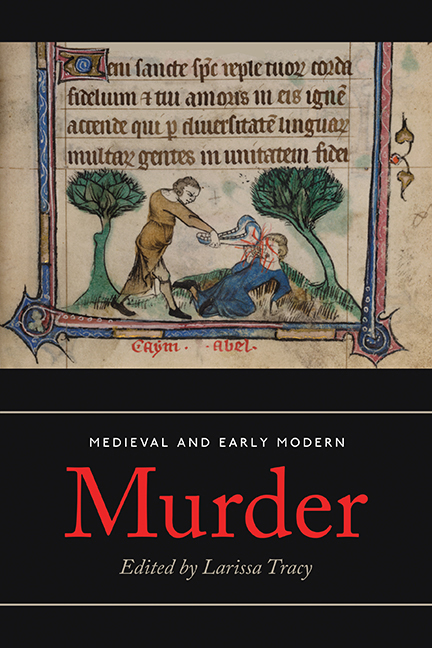Book contents
- Frontmatter
- Contents
- List of Illustrations and Tables
- Acknowledgements
- Contributors
- List of Abbreviations
- Introduction: Murder Most Foul
- I Murder on Trial: Justice, Law and Society
- II The Public Hermeneutics of Murder: Interpretation and Context
- 6 Bringing Murder to Light: Death, Publishing and Performance in Icelandic Sagas
- 7 ‘I Think This Bacon is Wearing Shoes’: Comedy and Murder in the Old French Fabliaux
- 8 ‘Chevaliers ocirre’: Manslaughter, Morality and Meaning in the Queste del Saint Graal
- 9 Murder, Manslaughter and Reputation: Killing in Malory's Le Morte Darthur
- 10 Poisoning as a Means of State Assassination in Early Modern Venice
- 11 Defamation, a Murder More Foul?: The ‘Second Murder’ of Louis, Duke of Orleans (d. 1407) Reconsidered
- 12 ‘A general murther, an universal slaughter’: Strategies of Anti-Jesuit Defamation in Reporting Assassination in the Early Modern Period
- III Murder in the Community: Gender, Youth And Family
- Conclusion
- Select Bibliography
- Index
11 - Defamation, a Murder More Foul?: The ‘Second Murder’ of Louis, Duke of Orleans (d. 1407) Reconsidered
from II - The Public Hermeneutics of Murder: Interpretation and Context
Published online by Cambridge University Press: 05 July 2018
- Frontmatter
- Contents
- List of Illustrations and Tables
- Acknowledgements
- Contributors
- List of Abbreviations
- Introduction: Murder Most Foul
- I Murder on Trial: Justice, Law and Society
- II The Public Hermeneutics of Murder: Interpretation and Context
- 6 Bringing Murder to Light: Death, Publishing and Performance in Icelandic Sagas
- 7 ‘I Think This Bacon is Wearing Shoes’: Comedy and Murder in the Old French Fabliaux
- 8 ‘Chevaliers ocirre’: Manslaughter, Morality and Meaning in the Queste del Saint Graal
- 9 Murder, Manslaughter and Reputation: Killing in Malory's Le Morte Darthur
- 10 Poisoning as a Means of State Assassination in Early Modern Venice
- 11 Defamation, a Murder More Foul?: The ‘Second Murder’ of Louis, Duke of Orleans (d. 1407) Reconsidered
- 12 ‘A general murther, an universal slaughter’: Strategies of Anti-Jesuit Defamation in Reporting Assassination in the Early Modern Period
- III Murder in the Community: Gender, Youth And Family
- Conclusion
- Select Bibliography
- Index
Summary
ON 23 NOVEMBER 1407, Louis, duke of Orleans, was brutally murdered in the streets of Paris. The provost of Paris, Guillaume de Tignonville, reported that between ten and twenty men attacked Orleans and his valet with swords, axes and clubs, beating him even after he had fallen to the ground dead. The surprise attack was gruesome, and every detail meticulously recorded by the chroniclers of the period, all of whom agreed that this was a shameful death for a royal body. Many commented on the great effusion of blood, which was an important narrative strategy to emphasise Orleans’ humanity, connecting his suffering to that of Christ. Their ultimate intention was to emphasise the heinousness of crime.
After the provost of Paris launched his investigation into the killing and the funerary rites had been performed, John, duke of Burgundy, admitted his guilt to his uncles, the dukes of Berry and Bourbon. According to the chroniclers, when John of Burgundy first confessed, he claimed the devil had incited him. However, when he was given the chance to present his formal justification on 9 March 1408, he changed his refrain and refused to admit that he had committed murder. Rather, his spokesman, Jean Petit, claimed Burgundy had committed a lawful ‘tyrannicide’. He argued that Orleans’ crimes of tyranny, attempted usurpation (which, together, amounted to lèse-majesté [high treason]) and divine lèse-majesté, gave him legitimate cause to kill Louis without due judicial process or the king's express consent. Through the process of defamation, the legal narrative John of Burgundy and his team of experts (re)constructed this murder as a legitimate execution, akin to that of any other man convicted of treason. The next day he was formally pardoned for the crime.
There are numerous points regarding this murder and the subsequent judicial process that make it a unique case. First, the two men involved were members of the royal family: the victim was the king's brother, and the killer their first cousin. Both were princes of the blood, a term used to identify and celebrate the most illustrious noblemen, the sons and grandsons of French kings.
- Type
- Chapter
- Information
- Medieval and Early Modern MurderLegal, Literary and Historical Contexts, pp. 254 - 280Publisher: Boydell & BrewerPrint publication year: 2018
- 1
- Cited by



